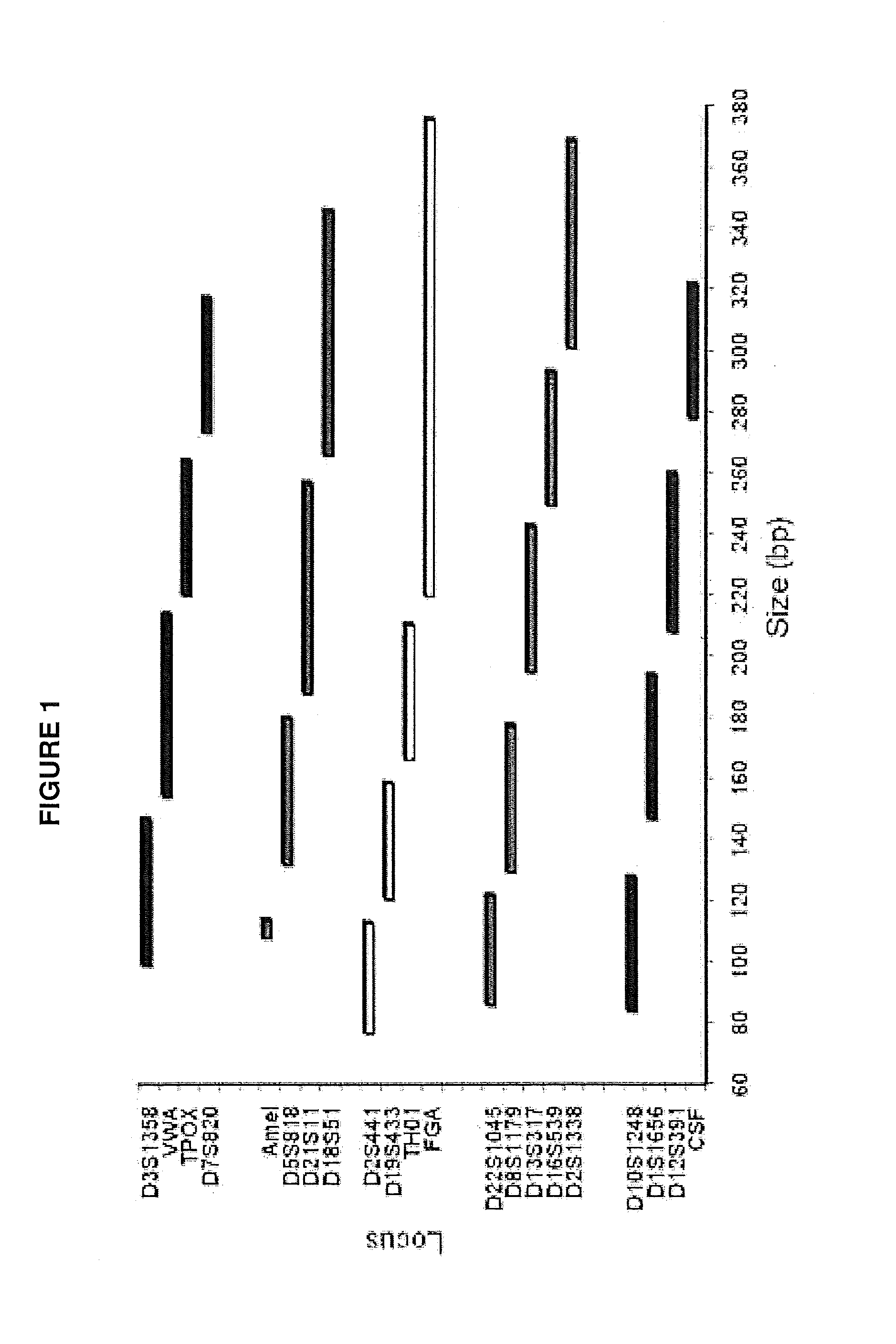Methods and kits for multiplex amplification of short tandem repeat loci
a technology of tandem repeat and multiplex amplification, which is applied in the field of compositions, methods and kits for multiplex amplification of short tandem repeat loci, can solve the problems of difficult or imprecise dna profile matching within and between databases, and achieve the effects of reducing the likelihood of adventitious matches, increasing international data overlap and compatibility, and increasing discrimination power useful
- Summary
- Abstract
- Description
- Claims
- Application Information
AI Technical Summary
Benefits of technology
Problems solved by technology
Method used
Image
Examples
examples
[0083]Aspects of the present teachings can be further understood in light of the following examples, which should not be construed as limiting the scope of the present teachings in any way.
example i
[0084]In certain embodiments, a DNA sample to be analyzed was combined with STR- and Amelogenin-specific primer sets in a PCR mixture to amplify the Identifiler® loci D7S820, D5S818, D13S317, D16S539, D18S51, D19S433, D21S11, D2S1338, D3S1358, D8S1179, CSF1PO, FGA, TH01, TPOX, VWA, Amelogenin, and five new STR loci D10S1248, D12S391, D1S1656, D22S1045, and D2S441. Primer sets for these loci were designed according to the methodology provided herein, supra. One primer from each of the primer sets that amplify D3S1358, VWA, TPOX, and D7S820 was labeled with the 6-FAM™ fluorescent label. One primer from each of the primer sets that amplify Amelogenin, D5S818, D21S11, and D18S51 was labeled with the VIC® fluorescent label. One primer from each of the primer sets that amplify D2S441, D19S433, TH01 and FGA was labeled with the TED™ fluorescent label. One primer from each of the primer sets that amplify D22S1045, D8S1179, D13S317, D16S539, and D2S1388 was labeled with the TAZ® fluorescent ...
example ii
[0092]In certain embodiments, a DNA sample to be analyzed was combined with STR-, a Y indel- and Amelogenin-specific primer sets in a PCR mixture to amplify the Identifiler® loci D7S820, D5S818, D13S317, D16S539, D18S51, D19S433, D21S11, D2S1338, D3S1358, D8S1179, CSF1PO, FGA, TH01, TPOX, VWA, Amelogenin, and seven new STR loci D10S1248, D12S391, D1S1656, D22S1045, D2S441 and Penta E along with Y STR DYS391. Primer sets for these loci were designed according to the methodology provided herein, supra. One primer from each of the primer sets that amplify D3S1358, VWA, TPOX, D7S820, and DYS391 was labeled with the 6-FAM™ fluorescent label. One primer from each of the primer sets that amplify Amelogenin, D5S818, D21S11, and D18S51 was labeled with the VIC® fluorescent label. One primer from each of the primer sets that amplify D2S441, D19S433, TH01 and FGA was labeled with the TED™ fluorescent label. One primer from each of the primer sets that amplify D22S1045, D8S1179, D13S317, D16S53...
PUM
| Property | Measurement | Unit |
|---|---|---|
| temperature | aaaaa | aaaaa |
| temperature | aaaaa | aaaaa |
| temperature | aaaaa | aaaaa |
Abstract
Description
Claims
Application Information
 Login to View More
Login to View More - R&D
- Intellectual Property
- Life Sciences
- Materials
- Tech Scout
- Unparalleled Data Quality
- Higher Quality Content
- 60% Fewer Hallucinations
Browse by: Latest US Patents, China's latest patents, Technical Efficacy Thesaurus, Application Domain, Technology Topic, Popular Technical Reports.
© 2025 PatSnap. All rights reserved.Legal|Privacy policy|Modern Slavery Act Transparency Statement|Sitemap|About US| Contact US: help@patsnap.com



